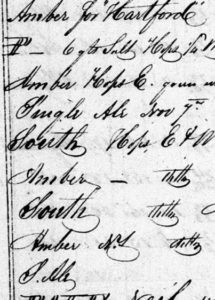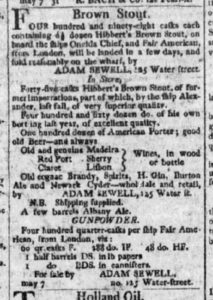 The main reason I got into hunting for parallels to IPA over six years ago was Pete Brown’s excellent book Hops and Glory. I liked it so much that I posted a review in four parts. It seemed to me that if beer was being shipped to India it should have been shipped across the Atlantic Ocean as well. And as it turned out my hunch was correct. It shouldn’t have needed to be a hunch, of course. This all should have been well researched but, as I have droned on about, there has been a tendency in beer writing to skip the whole research thing and rush to observation. So, we have wallowed in myth. In this post, like the one on how beer was commonly not pale and not smoke-laced before the use of coke for malting, let’s just summarize what is known so that we don’t ever have to slip back into the land of fibs where it takes the latter 1800s popularization of lager to invent the concept of the know-how and practice shipping of US beer over long distances to lucrative markets.
The main reason I got into hunting for parallels to IPA over six years ago was Pete Brown’s excellent book Hops and Glory. I liked it so much that I posted a review in four parts. It seemed to me that if beer was being shipped to India it should have been shipped across the Atlantic Ocean as well. And as it turned out my hunch was correct. It shouldn’t have needed to be a hunch, of course. This all should have been well researched but, as I have droned on about, there has been a tendency in beer writing to skip the whole research thing and rush to observation. So, we have wallowed in myth. In this post, like the one on how beer was commonly not pale and not smoke-laced before the use of coke for malting, let’s just summarize what is known so that we don’t ever have to slip back into the land of fibs where it takes the latter 1800s popularization of lager to invent the concept of the know-how and practice shipping of US beer over long distances to lucrative markets.
=> First, Taunton ale. As we have known for a few years, Taunton ale was imported in large quantities into New York City since at least the 1750s when newpaper notices for the stuff start appearing. It was brought to NY in the first two decades of the 1800s. It was certainly also in Jamaica in the later 1700s. We do not know how much of it was imported into other colonial communities solely because no one has researched the question as far as I know.
=>  Next, Hibberts Brown Stout. This stuff is all over the place. Click on that thumbnail. That is a notice from just one store in 1805 stating that they have fifty-five casks on hand with another 498 casks on route. British beer brought in and in bulk. Broadly. Nova Scotia. Texas. Lots of folk were importing. They knew how to put a cask on a ship.
Next, Hibberts Brown Stout. This stuff is all over the place. Click on that thumbnail. That is a notice from just one store in 1805 stating that they have fifty-five casks on hand with another 498 casks on route. British beer brought in and in bulk. Broadly. Nova Scotia. Texas. Lots of folk were importing. They knew how to put a cask on a ship.
=> And then, porter. As I recently wrote, it “was enjoyed in New York City as an import and then a local product in the second half of the 1700s, before and after the Revolution. The best was “ripe and brisk.” A brewery built in the 1760s by a Hudson River dock was known as the porter brewery for half a century. It shipped to both the East and West Indies. Again, masses of the stuff being shipped in and shipped out.
=> There’s New Haven ale, too. Worthy of its own post, New Haven, Connecticut ale appears in Albany (of all places) in 1802 in an ad that also have NYC ale coming north, too. There was an agency in NYC and some sort of Federalist plot related to the 1803 burning of the brewery. The brewery had enough barley for 1500 barrels of ale when it was destroyed. Scale.
=>  Plus, there’s southern beer. You see it in the logs. Click on the ad. Brewing was not practical below a certain latitude so brewers like William Faulkner of NYC and Albany shipped to South Carolina… and the West Indies. He died in 1792. Not to mention there was northern beer, too, three decades later. I haven’t even figured out what that was. Except it was shipped in bulk and was intended for trade.
Plus, there’s southern beer. You see it in the logs. Click on the ad. Brewing was not practical below a certain latitude so brewers like William Faulkner of NYC and Albany shipped to South Carolina… and the West Indies. He died in 1792. Not to mention there was northern beer, too, three decades later. I haven’t even figured out what that was. Except it was shipped in bulk and was intended for trade.
=> And, of course, there’s the entire history of Albany ale in the first half of the 1800s. Enjoyed from Newfoundland to Hawaii. Brewed at a scale that rivaled anything in Europe by mid-century and for decades after that.
=>  And it goes on and on – there was Burlington Ale and Philadelphia Cream. There was all that Philadelphia porter, too. And then there was just those notices for custom batched shipping beer, a purely wholesale product in the 1820s like under that thumbnail. Local and shipping were two distinct and equally valuable markets for the ambitious brewer in the early 1800s. That image way up there? A detail from Vassar’s log in August 1834. Like other every page, it shows how mixed his intended markets were. Why else do you think US ale breweries were built on rivers or near the
And it goes on and on – there was Burlington Ale and Philadelphia Cream. There was all that Philadelphia porter, too. And then there was just those notices for custom batched shipping beer, a purely wholesale product in the 1820s like under that thumbnail. Local and shipping were two distinct and equally valuable markets for the ambitious brewer in the early 1800s. That image way up there? A detail from Vassar’s log in August 1834. Like other every page, it shows how mixed his intended markets were. Why else do you think US ale breweries were built on rivers or near the
sea?
Why wouldn’t US brewed beer and ale be shipped in mass quantities well before the rise of lager? Ship’s beer is a core product. Ship + brewing = wealth. Just like they knew how to make pale ale without smoke fouling, the English knew how to load a ship full of beer for an expedition to the Arctic in 1577, for God’s sake. The Hanseatic League was shipping beer internationally before 1400. Why? Money! Just as with big craft today, every brewery owner has always known that getting past the local market is where the real money is. It’s the goal. The goose that lays the golden egg. When the great American lager breweries begin shipping by rail in the later 1800s they are just building upon centuries of bulk beer shipment under wind and sail. Albany may have been a leader but it was not unique. The more that actual brewing trade research is undertaken the more clearly this will be set out. Guaranteed.
